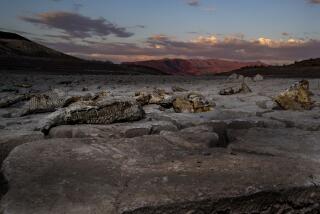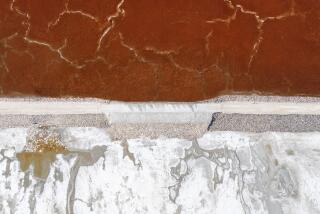West’s Farmers Are Praying for Drought Relief
Dan Knisley took his four boys by the hand and led them to the edge of Rye Patch Reservoir, where they knelt together. The sons took their cue from their father, bowing their heads and praying for that most elusive commodity in tiny Lovelock, Nev., and much of the West -- rain.
“The Bible says if God’s people would humble themselves and pray, he would heal their land,” said Knisley, a farmer.
But prayer can only do so much when the Western drought, now in its fourth year, is so bad.
Lovelock gets its water from the lower Humboldt River in northern Nevada, but the river is only 25% of average, meaning farmers’ income will be virtually nothing this summer. The reservoir is nearly empty.
Across the West, the news is much the same: Westerners are in for a long, dry summer with little relief from drought. The April 1 snowpack report -- critical because it’s typically the last major survey of the season -- was grim.
While the Rocky Mountains, from Montana to northern New Mexico, improved during March, with snowpacks near or just above average in many basins, snowpacks in parts of Nevada, Oregon, Utah and Arizona were less than 50% of average.
“It’s bad, really bad,” said Randy Julander, snow-survey supervisor for the Natural Resources Conservation Service in Salt Lake City. “We have very poor reservoir storage because we’ve used a ton of it over the past five years. It makes for a pretty bleak water-supply picture.”
Storms dumped heavy rain and snow on Colorado last month, and the state, along with parts of Wyoming, Idaho and Montana, has average to above average snowpacks, with a few spots approaching 50% above average. But that probably will not make much difference as summer approaches.
“It’s only maybe 5% [to] 10% of the West that we have that type of snowpack,” said Phil Pasteris, supervisory physical scientist with the NRCS in Portland, Ore. “The catch is, that area was very dry last year, so there’s a chance you won’t get as much runoff because of the dry soil.”
Reservoir storage isn’t much better than the snowpack. Four states -- California, Idaho, Montana and Washington -- are near average, but storage in the rest of the West is well below normal, according to an NRCS report issued last week.
“There’s probably not a Western state that is sitting real pretty,” said Kelly Redmond, regional climatologist for the Western Regional Climate Center in Reno. “Nobody is going into the summer season with a real fat supply in their reservoirs.”
In Oregon, snowpack is 55% of average despite getting a lot of snow during March. Reservoirs in the state are only 66% of average.
“I can’t really think of anything good,” said Stan Fox, snow hydrologist for the NRCS in Portland. “There [are] going to be shortages for irrigation water, shortages for feeding livestock. Springs could dry up or dry up earlier than usual.”
Last year at this time, the state’s snowpack was 132% of average.
And the drought probably won’t get much better.
“Full recovery is going to take almost like a biblical event to happen,” Pasteris said.
It’s not just the water supply that will be hurting. Trees devastated by drought will have a harder time fending off insects, leading to more dead timber that will increase the fire danger.
Redmond also said large infestations of Mormon crickets in the Great Basin area are likely this summer.
“We don’t have a lot to pin our hopes on,” he said.
Knisley, 37, knows that, but figures asking for divine intervention can’t hurt. He farms 3,000 acres of alfalfa and wheat in rural Lovelock -- 90 miles northeast of Reno -- but may only be able to farm 1,000 acres this year.
He is trying to sell half his farm equipment to get more money.
One recent Saturday, Knisley, his wife, four sons and 1-year-old daughter gathered near the Rye Patch Reservoir with about 20 members of Knisley’s church and another church in nearby Fallon. The group held hands, got down on their knees and asked for relief in this farming-dependent community.
“It’s just out of my control,” Knisley said.
“I pray that God would bring a storm. I pray all the time.”
*
On the Web:
www.drought.unl.edu/dm/index.html
www.nrcs.usda.gov
More to Read
Sign up for Essential California
The most important California stories and recommendations in your inbox every morning.
You may occasionally receive promotional content from the Los Angeles Times.










